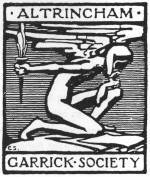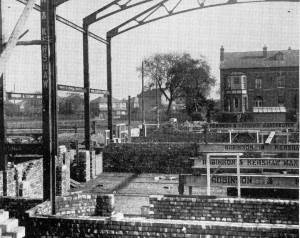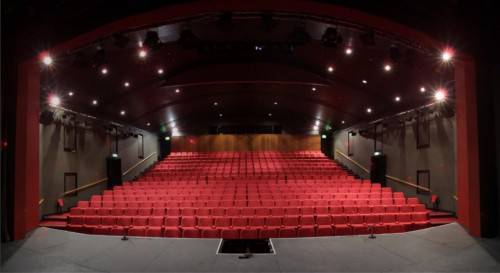The History of the Theatre
The Garrick has a long and illustrious history from its initial stirrings in November 1913 through to the major redevelopment completed in 1999.
Those who are interested in a more complete account than is presented here may wish to purchase a copy of The Flame Still Burns, the story of Altrincham Garrick Playhouse compiled by a true Garrick stalwart, the late Pamela Knox.
Copies are still available from the theatre (at the give-away price of ONE pound only) and cover the tale from its inception to the 1992/93 season.
1913 – 1999
1913, November 25th – Inaugural meeting and formation of a provisional committee, followed by two further meetings in December
1914, January 20th – First meeting proper held in the new headquarters, the cellar of Mr Jack Byrom’s shop in Kingsway. The name of Altrincham Garrick Society adopted
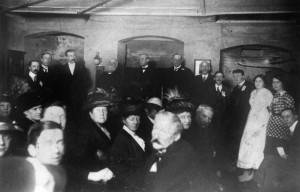
1914, February 17th – First Rehearsal of the First Play, The Silver Box by John Galsworthy
1914, March 18th – First Production (The Silver Box) performed at the Public Hall, Altrincham with scenery hired from the Gaiety Theatre, Manchester
1915, May 4th – a number of members were struck off the list for non-payment of subscriptions (a warning for some of us these days!)
1916, May – Productions were suspended because of the difficulties arising from the war
1920 – Following an attempt to persuade George Bernard Shaw to allow a production of Major Barbara without paying royalties, the great man advised the theatre to become a Repertory Theatre, paying the actors, since this would result in a lower payment of royalties (unless very successful!). As a result of this the play was produced and all actors paid five shillings, which was promptly taken back by the Treasurer and put into a Building Fund, with the aim of building our own theatre
1923, January – ‘Fred Arnold Enterprises’ wrote to the society offering to stage Garrick productions on a commercial basis. This offer was not accepted!
1924, June – Membership now stood at 813
1926, June – At the AGM it was announced that a plot of land had been acquired on Barrington Road suitable for building the proposed new theatre. The land had been purchased by an anonymous member and the Society would hold it on payment of the chief rent only. It eventually emerged that the benefactor was A.P.Hill, a founder member who had worked tirelessly towards the goal of a theatre in its own grounds.
1927, September – Mr R A Smith, who had produced the vast majority of plays since 1914, resigned as producer
1928, December – the ‘Sell a Brick for 2d’ scheme was inaugurated – by October 1930 the scheme had raised £37. 2. 6d (£37.12½ in today’s money!)
1930, September – Membership hit 1000
1931, July 14 – the first sod was cut at Barrington Road by Jack Byrom and the building of today’s theatre was begun
1931, October 29 – Garrick Playhouse Ltd registered as a public company
1932, October 1st – The first play opened at the new playhouse – ‘The Immortal Lady‘ by Clifford Bax
1935, February 13th – Standards of behaviour had clearly deteriorated seriously and the Executive Committee issued the following notice:-
- The Committee regrets that the unofficial sanction to members of the cast bringing intoxication liquor into the Playhouse is being considerably abused. It is necessary, therefore, to remind members that:
- 1) Only members actually taking part in a play, stage staff and producer, are allowed to bring beer, etc. into the dressing rooms.
- 2) All glasses must be washed immediately after use and all bottles, whether full or empty, must be kept in closed bags or receptacles
- 3) Members in the cast cannot be allowed to offer drinks to their members not in the cast, nor to non-members.
- 4) Members of the cast are asked to refrain from drinking beer etc. until they have finished their part each evening.
1935, March 11th to 18th – the 21st birthday of the Garrick Society was celebrated by the production of the Chinese play ‘Lady Precious Stream‘ , its first amateur production
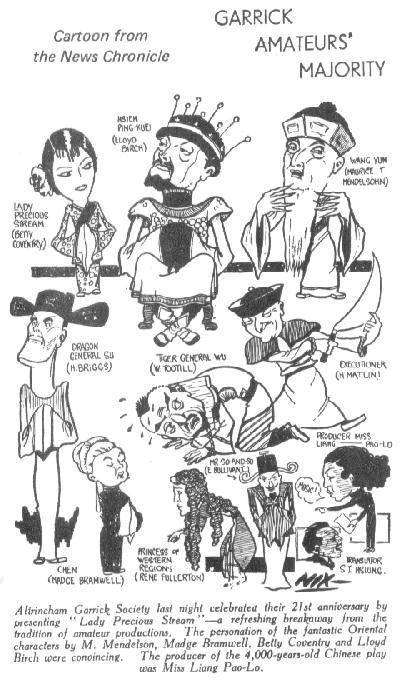
1935, August – Ruth Dunning, who first appeared at the Garrick in 1934, took over the role of Sally from Wendy Hiller in ‘Love on the Dole‘ at the Garrick Theatre, London, the first Garrick amateur to be successful as a professional
1939 – The Silver Jubilee play was ‘1066 and all that‘, with a cast of 150, 27 scenes and 3 levels
1939 – From a piece by ‘John Falstaff‘ of the Manchester Evening Chronicle – The Altrincham Garrick is one of the show places of the British Amateur Movement and its merit is twofold. First, it is secure and permanent; second, not only is the normal standard high, but the achievement also. There are few professional companies with such a striking list of pioneer efforts in plays and authors.
1939 – 1945 – For the duration of the war the theatre was handed over to a professional company, although the Society still provided staff and looked after the running of the building
1945, October – The first post-war production was ‘The Good Companions‘ by J B Priestley
1953 – A new building fund was started to be used for the erection of a small theatre at the rear of the Playhouse for experimental plays etc.
1957, October – the 25th anniversary of the Playhouse was celebrated by a production of ‘Teahouse of the August Moon‘
1958 – a Young Garrick Club was started for 15 to 18 year olds, soon named ‘Studio G’. Their first production was staged in June 1960 in the rehearsal room.
1961, September – The Garrick Bar opened for the first time, the first bar steward being Reg Hughes. He was succeeded early in 1962 by Albert Riddell who was to remain an indispensible part of the Garrick scene until 1981
1963, May – The first of five years of BBC radio recordings of Music Hall at the Garrick
1963 – 50th Jubilee Season – The theatre was re-decorated inside and out and a new central heating boiler installed – The main Jubilee production was ‘Becket‘
1965, January – First staging of the now famous Garrick Pantomime – that year it was ‘Aladdin‘
1968-69 – The ‘collection’ system of raising revenue at performances was finally dispensed with and a charge made for tickets
1972-73 season – The 40th anniversary of the Playhouse – the Foyer was modernised with a new Box Office, there was new decoration and, most important, re-upholstered seating. Supporters were invited to endow a seat in the theatre, with £5 securing a name plate affixed to the seat
1973, May – It was announced that while membership would continue performances would be open to the Public and advertised as such
1976 – A thrust stage installed during the close season
1977, August – The Garrick made its first appearance at the Royal Exchange with ‘Serjeant Musgrave’s Dance‘
1982, August – First visit to the Edinburgh Fringe with two home-grown Kevin Madley plays and Edward Bond’s ‘Bingo‘
1982, September – The season opened with a world stage premiere of ‘Psycho‘
1984, July – The Garrick produced a Music Hall as a part of the Edwardian Extravaganza in Dunham Park
1988-89 – The Society’s 75th Anniversary season – Stage 2 (the natural successor to Studio G) presented ‘Oh What a Lovely War‘ to mark the occasion
1990 – the Northern Amateur Premiere of ‘La Cage Aux Folles‘ – Little did we realise then what had started; this was the first of seven productions of it!
1990, November – Redevelopment fever had started. At an Extraordinary General Meeting an ambitious modernisation project which including selling the land on which the theatre stood and leasing the theatre back at a low rent for 999 years was rejected, but the drive had begun and the S.T.A.G.E. fund was started with the aim of raising £500,000 by December 1992
1992, July – the first Garrick Playathon. A host of members arrived at the theatre on Friday evening to discover that the show they were to perform on Sunday evening was ‘The Boyfriend’ by Sandy Wilson. After a massive amount of work pulled together by four directors, two musical directors, two choreographers and four set designers a superb performance was given on the Sunday evening (requiring a massive three prompts during the entire show!)
1998 – The Garrick’s third bid for National Lottery funding was successful, resulting in a grant of £675,000 as part of the £900,000 project.
1999 – The 1998/99 season finished early, in March, and the gutting of the auditorium began. The artistic side of the enterprise was kept occupied with a major open air production in Dunham Massey Hall of “Tom Jones” while the refurbishment went ahead. The grand (if a little delayed) reopening took place in October with a glittering production of “Camelot” (and a good deal of last minute rushing around!). The verdict was unanimous – Coming to the Garrick for a night out is now a real, and very comfortable, treat. Spread the word!
To coincide the start of the first season in the refurbished Playhouse, the Society also started with it’s own website, created and run by Richard Sails. Richard has managed the original website for 14 years until it was relaunched – since then the website has been managed by Stephen Bradshaw.
2006 – Following the generous donation of some tiered, retractable seating by The Lauriston Trust, the newly christened Lauriston Studio was officially opened to the public in October 2006 with a memorable production of ‘Two’ by Jim Cartwright. Seating only 49 people, it is an extremely intimate and stimulating theatre space that has become a fully integral part of the Altrincham Garrick Playhouse. Since then The Lauriston Studio Theatre has produced many exciting and cutting edge productions and has won awards for the quality of work produced there.
2013 – For the start of the 2013/14 Centenary season the Playhouse relaunched it’s revamped website
2014 – The Society celebrated their 100th Season – Here is their Centenary Brochure – designed by Stephen Bradshaw

